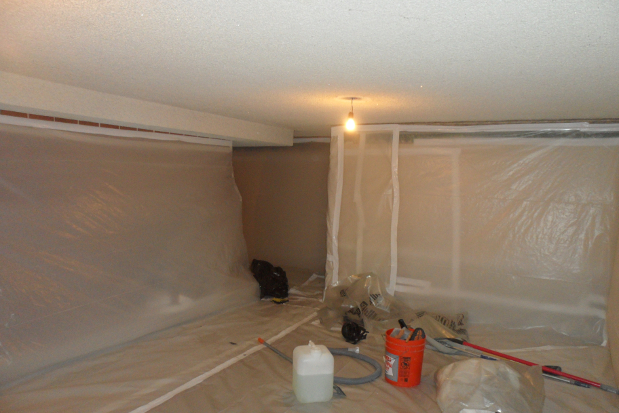
Asbestos is a naturally occurring mineral fiber processed into thousands of building materials before 1980, including “cottage cheese” type and acoustic tile ceilings, furnace and duct insulation, drywall taping and joint compound, textured paints and plasters, and linoleum and vinyl flooring. It was banned from use in most building materials in the 1970s after the EPA proved that inhaling asbestos fibers caused and/or increased the risk of developing incurable lung diseases, including lung cancer, asbestosis and mesothelioma.
Asbestos exposure poses a health hazard when its fibers are released into the air where they could be inhaled. The most prevalent health risk is posed by the original acoustic ceiling spray found in residences built before 1978 because that can be disturbed so easily to release fibers into the air, on clothing and carpeting.
When disturbing or making repairs on materials made of asbestos or remodeling homes constructed with materials containing asbestos, a certified asbestos abatement contractor must properly remove all affected hazardous materials according to OSHA regulated practices. Outdoors, construction and other activities can also churn up naturally occurring asbestos to create a potential hazard and must also be properly handled.
Asbestos abatement (removal) must be handled by a licensed and certified hazardous material contractor. This process starts by removing furnishings and sealing the affected area with several area of plastic. Next, powerful fans (called negative air machines) are brought in to the pump air through High Efficiency Particulate Air (HEPA) filters and out of the work space. Workers must also wear protective suits and respirators equipped with HEPA filters while working. All hazardous materials must be placed in double-layered hazardous waste bags labeled for asbestos and washed before being carried out of the work area. Upon completion, they remove the plastic and dispose of it with the rest of the materials through a hazardous waste disposal company.The average cost for this is typically between $1,000 and $2,500.
Certified hazardous material abatement companies may be hired for removal only, but most are also licensed general contractors equipped to complete the repair or remodeling project.
Ready to start your toxic material removal?
Find ProsMolds and mildews growing in the home may pose health risks and/or signal water intrusion and damage that will only become more extensive-and expensive-as time goes on.
People can suffer respiratory ailments, headaches and dizziness from common house molds and mildews growing in the wood, wall board, carpets, upholstery, air ducts and other areas in their homes. Even if not detected by sight or smell, black molds can make people sick, especially during cold weather when windows and doors are kept closed and contaminated air recirculates through the house’s heating system.
Having the air ducts professionally cleaned, installing an electrostatic air filter and hiring a professional service to clean all the carpet and upholstery will help with household mold remediation and keep mildews from circulating through your heating system and prevent their return.
Licensed and certified water damage specialists are trained and equipped to remove the mold which can occur due to water leaks and make all repairs. Although each situation is unique, the following procedures are usually followed:
- The leak or other source of water intrusion must be eliminated so that once the microorganisms are killed, they cannot grow back.
- The microorganisms (mold or mildew) are removed and the affected areas are sanitized with antimicrobials.
- The affected area must be thoroughly dried to prevent future growth. If building materials have been damaged from the microorganisms (dry-rot) they must replaced.
 Lead Paint Common Sense
Lead Paint Common Sense  How Do I Get Rid of the Moldy Odor in My Basement?
How Do I Get Rid of the Moldy Odor in My Basement?  Guide to Room-by-Room Repairs for Easy Accessibility for Disabled Loved Ones
Guide to Room-by-Room Repairs for Easy Accessibility for Disabled Loved Ones  Pool Safety Guide for Homeowners
Pool Safety Guide for Homeowners  Your Home’s Circulatory System: Heating and Cooling Air Ducts
Your Home’s Circulatory System: Heating and Cooling Air Ducts 

If mold is located in bathroom of master bedroom would i have to move out of house for the contractor or hazmat people so they could fix it
can you have mold and not have asbestos